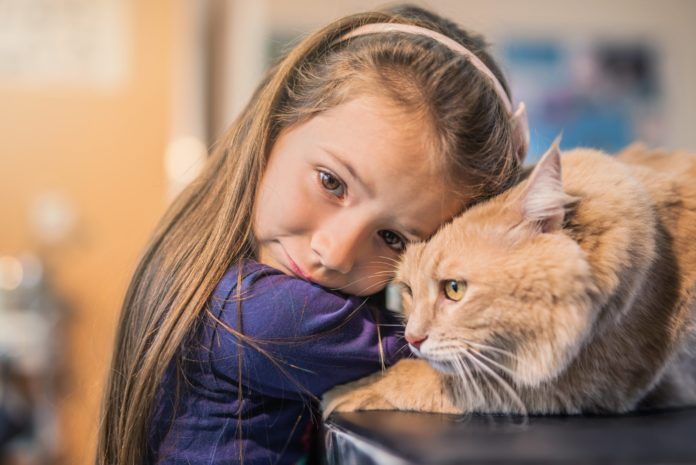@ DjelicS/Getty Images


Cancer. The word alone evokes high emotions, whether it’s impacting a family member, friend or beloved pet. Our thoughts tend to run from astonishment to guilt and fear as we grapple to come to terms with the new reality and what to do next. Like humans, our pets are also living longer these days — and that fact alone contributes to the likelihood of our cats one day developing cancer.
According to the Veterinary Cancer Society, approximately six million dogs and nearly that many cats will be diagnosed with cancer each year; 47 percent of dogs die from cancer — especially dogs over the age 10 — and 32 percent of cats will succumb. While cancer isn’t as prevalent in cats as it is in dogs, cancer in cats does tend to be more aggressive. This may be due in part to the cat’s protective skill in concealing pain and illness, which can make diagnosing the disease more difficult until it’s at a more advanced stage and harder to manage and treat.
According to Dr. Kristine E. Burgess, a specialist in medical oncology at the Cummings School of Veterinary Medicine, “The difference between cat cancer and dog cancer is that, I think, fewer people seek treatment for their cats than for dogs. This sadly reflects the historical view that maybe they don’t value cats as much as dogs. Also, veterinary advancements in feline treatments have been slower. When people learn that I treat cats with cancer, some think it’s funny, and I find that to be really sad.”
Dr. Burgess also believes that there are some misconceptions about cats and cancer that need to be cleared up. “People need to know that treatment is available for cats, and some other big myths about treatment need to be debunked. The biggest myths I hear are: ‘treatment is really expensive,’ ‘it’s really impactful on their quality of life’ and ‘it’s just a cat and people can get a new cat.’ People need to know that treatment isn’t out of their reach financially, that we are able to maintain a good quality of life for the pet and that cats are valuable and worthy of care.”
Quality of life comes first
While there are several treatment options available, it’s important to know that not all types of cancer respond well to treatment and some treatments are only available at specialty hospitals. The decision to treat or not to treat, how to treat, and the accompanying side effects must be carefully weighed while putting the cat’s quality of life first. Knowledge is power, so it is critically important to discuss your options in depth with your veterinarian before making your decision. The options include referral to a specialist such as Dr. Burgess.
Before any treatment begins, the pet will undergo a series of “staging” tests to determine the extent of the disease within the body. “The staging tests provide us with a baseline of your pet’s general health, if there are other comorbid conditions — such as kidney or heart problems — and provides us with information on the severity of the cancer,” explains Dr. Burgess. This information is crucial in guiding treatment recommendations and better understanding a pet’s prognosis.
Treatment options
There are three primary therapy options for cancer: surgery, radiation therapy and chemotherapy. Some of the treatments may be available at general practice veterinary clinics, whereas others are only available at specialty hospitals. The appropriate treatment depends on many factors — including the type of cancer, its location and whether the cancer has spread to other parts of the body. It also depends on what’s appropriate for the individual cat and what’s practical, affordable and accessible to the pet owner. All of these concerns should be discussed in depth with your veterinarian.
Surgery is the most common form of therapy. “There’s an old expression that a chance to cut is a chance to cure,” says Dr. Burgess. But it does depend on the cancer and the individual cat. “If you have a cancer localized to one area, and it is not known to have a high propensity to spread to other areas, or metastasize, then good local control through surgery can provide long term tumor control. However, a lot of cats, for some reason, tend to get cancers that have a higher chance of returning at the site where surgery has been completed or spread to other locations.”
Radiation therapy uses external beam radiation, similar to X-rays, from a machine known as a linear accelerator. “This is the type of radiation therapy offered at Tufts small animal hospital. The machine focuses high energy beams to the tumor site and the procedure lasts a few minutes. We often use it in conjunction with surgery to address any cancer cells that may be left behind after surgery. It is usually very effective for cancers we know to be responsive to radiation therapy. In cats, the common uses would be for lymphoma in the nose, or nasal lymphoma, for some oral cancers and brain tumors. Oftentimes radiation is used on vaccine-associated sarcomas,” says Dr. Burgess.
Tumor determines treatment
The tumor type determines what radiation protocol will be used. “If the oncologist determines that a pet has a good chance to live for a long period of time after the treatment, the pet could receive radiation treatment every day for up to three to four weeks with the hope that the pet may live for another one, two or even three years or longer. With these protocols, the pet may experience some minor side effects that look like sunburn at the location, but we expect a gain in life expectancy,” says Dr. Burgess.
Dr. Burgess says other side effects may include a loss of fur that doesn’t return, or fur growing back in a different color (for example, a black cat’s fur may grow in white). If the radiation is administered to the mouth, the cat could develop inflammation of the oral cavity; if administered to the back of the throat, they may develop inflammation of the pharynx. Basically, it is an acute inflammation that usually resolves within two weeks with supportive care.
Palliative radiation therapy is a much less intensive protocol in which the cat receives fewer treatments with the goal of shrinking the tumor, or preventing further tumor growth for a period of time. The goal of these protocols is strictly preserving the pet’s quality of life for a variable amount of time. This option may be used if pain is associated with the mass, or if the tumor is impacting a pet’s ability to enjoy a good quality of life.
Radiation therapy is most often offered at specialty hospitals. The cost varies with the protocol used, ranging from approximately $2,000 to $7,000, and may vary by location. The Veterinary Cancer Society website has list of facilities that offer radiation therapy. (http://www.vetcancersociety.org/pet-owners/)
Chemotherapy is a form of drug therapy for cancer. “The most common cancer we see in dogs and cats is lymphoma, which happens to be the most responsive to chemotherapy,” says Dr. Burgess.
The drugs used to treat cats with cancer are the same as those used to treat people, but the goal in cats is good quality of life. With humans, there is a focus on a cure — and as a result, people receive much more aggressive protocols. “Our goal is to treat the cat so that he isn’t impacted by the therapy at all. The drugs are usually administered intravenously, and depending on the protocol and the cancer, the treatment could be once a week for a period of time, every other week, every three weeks; it varies quite bit,” says Dr. Burgess.
Supportive medications are generally sent home to counter side effects such as nausea, vomiting and diarrhea. If the side effects are more serious, the dose of the next chemotherapy treatment can be reduced in an effort to avoid them in the future. “The goal is to avoid side effects, while preserving the quality of life,” says Dr. Burgess.
With chemotherapy, cats don’t lose their fur, but they may lose their whiskers, which will grow back.
The prognosis for cats receiving chemotherapy varies according to the same factors as other forms of treatment, including type of cancer, how responsive it is and the individual cat. Dr. Burgess says, “It seems counterintuitive that a cat with cancer could gain weight while on chemo, but when you’re treating the disease appropriately, he’ll go back to being able to absorb nutrients, regain his appetite and regain his weight. Ideally, if we’re successful in our treatments we can bring him back to being the cat he was before he got cancer.”
The cost for chemotherapy depends on the recommended protocol (whether once a week, every other week or every three weeks) and the drugs used. The average cost is about $250 per treatment for a cat, says Dr. Burgess. Some general practices can administer chemotherapy. “I’d rather have a cat get chemotherapy than not get it because an owner doesn’t think they can afford a medical oncologist.”
Financial considerations often play a role in the decision making process for owners. Many veterinary specialty or teaching hospitals conduct clinical trials that may provide financial assistance for participation. These can provide an excellent opportunity not only to help your own cat, but to help many other cats in the future. — Ramona Marek MS Ed.




